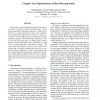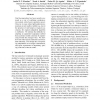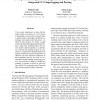127
click to vote
CVPR
2012
IEEE
13 years 3 months ago
2012
IEEE
We describe a novel max-margin parameter learning approach for structured prediction problems under certain non-decomposable performance measures. Structured prediction is a commo...
121
Voted
CVPR
2012
IEEE
13 years 3 months ago
2012
IEEE
We present a novel framework for multiple object tracking in which the problems of object detection and data association are expressed by a single objective function. The framewor...
130
Voted
EMNLP
2011
14 years 10 days ago
2011
Dual decomposition has been recently proposed as a way of combining complementary models, with a boost in predictive power. However, in cases where lightweight decompositions are ...
130
click to vote
AAAI
2011
14 years 18 days ago
2011
We present a dual decomposition approach to the treereweighted belief propagation objective. Each tree in the tree-reweighted bound yields one subproblem, which can be solved with...
146
click to vote
ICCV
2011
IEEE
14 years 19 days ago
2011
IEEE
This paper proposes a very general max-margin learning framework for distance-based clustering. To this end, it formulates clustering as a high order energy minimization problem w...
126
click to vote
ACL
2011
14 years 4 months ago
2011
Via an oracle experiment, we show that the upper bound on accuracy of a CCG parser is significantly lowered when its search space is pruned using a supertagger, though the supert...
120
click to vote
EMNLP
2010
14 years 10 months ago
2010
This paper introduces algorithms for nonprojective parsing based on dual decomposition. We focus on parsing algorithms for nonprojective head automata, a generalization of head-au...
125
click to vote
CDC
2009
IEEE
15 years 5 months ago
2009
IEEE
Abstract— Many problems associated with networked systems can be formulated as network utility maximization (NUM) problems. NUM problems maximize a global separable measure of ne...
136
click to vote
CDC
2009
IEEE
15 years 5 months ago
2009
IEEE
— Most existing work uses dual decomposition and subgradient methods to solve network optimization problems in a distributed manner, which suffer from slow convergence rate prope...
CVPR
2010
IEEE
15 years 9 months ago
2010
IEEE
Graph cuts methods are at the core of many state-of-theart algorithms in computer vision due to their efficiency in computing globally optimal solutions. In this paper, we solve t...



